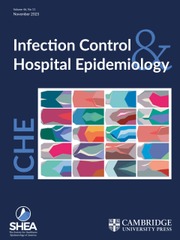Dear Editor,
Due to the shortage of Becton Dickinson (BD) BACTEC™ blood culture media bottles, hospitals worldwide have faced a challenging situation. 1 Blood culture is essential for diagnosing bloodstream infections, and the unavailability of blood culture bottles may discourage the ordering of blood culture tests, thereby increasing the risk of delays in accurate diagnosis and treatment for septic patients. Unnecessary blood culture testing exacerbates the shortage, and laboratory and infectious diseases personnel addressed this urgent issue by advocating for proper blood culture ordering or reducing the number of blood culture bottles (from routine two-set testing to one-set per test by default). Clinical evidence on promoting diagnostic stewardship has been evaluated, and recent data indicate that unnecessary blood cultures can be omitted without a rise in adverse events, thus supporting the reduction in the redundant use of blood culture bottles. Reference Fabre, Carroll and Cosgrove2–Reference Temkin, Biran and Braun4
Upon reconsidering the clinical importance of blood culture testing, we question whether it is ideally processed and reported in healthcare settings. Positive blood culture results indicate a diagnosis of bacteremia, which has a high fatality rate and thus requires rapid treatment. Most healthcare facilities treat it as a “critical value” that must be reported directly and immediately to the attending physicians. Hospitals with 24-hour in-house microbiology laboratories may be able to establish such an around-the-clock reporting system. However, many Japanese hospitals, including even large tertiary referral facilities, do not yet have a 24-hour reporting system, with few exceptions. Reference Nishiyama, Osawa and Nakamura5 Unfortunately, this seems not unique to Japan. According to a cross-sectional survey conducted across European microbiological laboratories (encompassing 209 facilities across 25 countries) published in 2019, merely 13% (25/192) had implemented continuous 24-hour operational protocols for the immediate processing of positive blood culture specimens, and only 4.7% (9/190) answered they reported identification and antimicrobial susceptibility testing results for 24 hours. Reference Idelevich, Seifert and Sundqvist6
To elucidate and address this issue, we have reviewed our microbiology recording data. From July 2020 to July 2024, we collected data on 4,296 positive blood culture bottles. As shown in Figure 1, 68.4% of blood culture bottles were submitted to the microbiology laboratory during the working hours (8 A.M. to 6 P.M.). Among these, only 38.7% of the bottles were identified as positive during working hours, while 61.3% showed positive signals during off-hours (6 P.M. to 8 A.M.). Our hospital microbiology laboratory operates on Saturdays (9 A.M. to 5 P.M.) but is only partially open on Sundays and other holidays (9 A.M. to 12 P.M.). Consequently, two-thirds to three-quarters of blood culture bottles yield positive signals during off-hours, delaying notification to clinicians by up to 14 hours (weekdays) to 20 hours (weekends) at most.

Figure 1. The number of blood culture tests submitted to the laboratory (A) and the number of positive cases (B). Green columns indicate working hours (8 A.M. to 6 P.M.), while gray columns represent off-hours (6 P.M. to 8 A.M.). Data for Saturdays, Sundays, and other holidays are included as well, and the proportion of positive blood culture during off-hours is higher than indicated.
Considering the solid fact that the sooner the initiation of treatment, the better the clinical outcome, this unfavorable situation needs to be improved. Patients with suspected sepsis or bacteremia often receive empirical antimicrobial therapy prior to blood culture results. However, clinical decision-making varies based on patient presentation and risk factors. Some patients undergo blood culture screening with watchful waiting rather than immediate antimicrobial intervention. Furthermore, empirical therapy may not provide adequate coverage against the causative pathogen, particularly in cases involving resistant organisms or uncommon pathogens. This variability in clinical scenarios underscores the importance of rapid and accurate blood culture results for optimizing antimicrobial therapy.
There are three possible solutions to be noted. The first is hiring more microbiology technicians to establish a 24-hour reporting system, which, however, would be costly. Although a cost-benefit analysis needs to be thoroughly scrutinized, it is generally challenging to make a significant profit from microbiological testing, and increasing the number of microbiology technicians may not be a feasible solution. The second option is to mandate that night-duty technicians handle blood culture reporting. However, microscopic evaluation of blood culture samples requires repeated practice and experience, which may be stressful for those who are not well-versed in it and can result in misreporting. The third idea involves the development of fully automated equipment capable of completing bacterial identification (estimation) for positive blood culture bottles. However, to the best of our knowledge, such high-tech devices are not yet available. Finally, a feasible operational solution is the implementation of late-shift scheduling in clinical microbiology laboratories. While clinical laboratory technologists in typical healthcare facilities generally work from 8:30 A.M. to 5:30 P.M., introducing a late shift starting at 12:00 P.M., for example, would enable laboratory operations to extend until approximately 11:00 P.M.. This structural modification could facilitate rapid reporting of blood culture results for a greater number of specimens without requiring substantial staffing expansion.
Equally important is the response on the clinical side. Even if a 24-hour reporting system for blood culture tests is established within the laboratory, it is often challenging to contact the responsible physician during off-hours. Night-duty or on-call doctors receiving positive results may not be able to make immediate and appropriate decisions regarding the patient’s treatment plan. Depending on the situation, if the test results are not thoroughly evaluated and applied clinically, the efforts of the laboratory become futile.
Collectively, there is an urgent need to develop a 24-hour rapid reporting system for blood culture results, including off-hours. In addition to addressing the shortage of blood culture bottles, efforts should also be made to mitigate the normalized delays in reporting blood culture results to the clinical side.
Acknowledgments
None to report.
Financial support
None to report.
Competing interests
None to declare.
Ethical standard
The need to obtain informed consent from each patient was waived because of the fully anonymized nature of the data.




